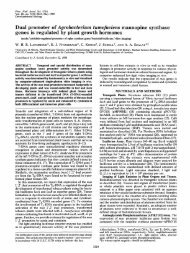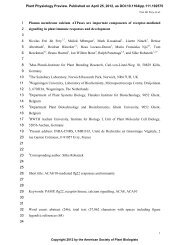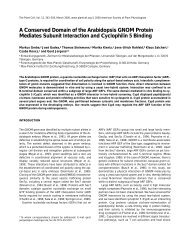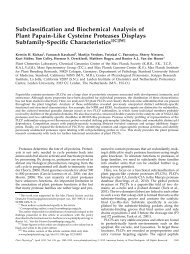1 Transposon and T-DNA mutagenesis
1 Transposon and T-DNA mutagenesis
1 Transposon and T-DNA mutagenesis
You also want an ePaper? Increase the reach of your titles
YUMPU automatically turns print PDFs into web optimized ePapers that Google loves.
t<br />
mutant phenotypes (4). The first gene that was isolated from this insertional<br />
mutant collection was GLI, a gene involved in trichome formation (60), but<br />
many more T-<strong>DNA</strong> tagged genes isolated from this population demonstrated<br />
the success of T-<strong>DNA</strong> tagging (5).<br />
Another large population of over 3000 transformants was made in the<br />
Columbia ecotype by tissue culture transformation (61). A number of these<br />
transformed lines are also available from NASC (see Chapter 1) (38). From a<br />
small subset of 450 transformants, a pale mutant was identified, shown to be<br />
T-<strong>DNA</strong> tagged, <strong>and</strong> the corresponding CH42 gene was isolated (62).<br />
A problem thought to be associated with transformation by tissue culture<br />
methods is the generation of somaclonal mutants that have nothing to do with<br />
T-<strong>DNA</strong> insertion. However, it was found that non-tagged mutants were also<br />
frequently produced by other transformation methods, such as the seed transformation<br />
(4). In a screen of 1340 tissue culture transformed lines, 25.07%<br />
showed a mutant phenotype. Interestingly, the mutation frequency <strong>and</strong> the<br />
mutation spectrum reported are similar for the seed <strong>and</strong> tissue culture transformants<br />
(4,6). The high mutation frequency seems very promising for gene<br />
tagging, but it has to be noted that many of the observed mutations did not cosegregate<br />
with a T-<strong>DNA</strong> insert. Castle et al. (63) performed an extensive<br />
characterization of 178 embryonic mutants derived from the seed transformants.<br />
They found that only 36% of the 115 mutants examined were actually tagged<br />
by T-<strong>DNA</strong>. Among tissue culture-derived transformants, Van Lijsebettens et<br />
al. (64) reported that only one out of seven mutants was T-<strong>DNA</strong> tagged.<br />
Koncz et al. (6) estimated that the proportion of T-<strong>DNA</strong> tagged mutants with<br />
an observable phenotype in their collection is 10-30%, stressing the importance<br />
of careful genetic iinkage analysis before going into the process of gene<br />
cloning.<br />
Recently, a very simple whole plant transformation procedure was published<br />
by Bechtold et al. (65) offering a practical possibility for high density gene<br />
tagging. Accordingly, these authors plan to generate a saturated T-<strong>DNA</strong><br />
insertional mutant collection which they think will be reached by 50000 to<br />
100000 independent insertions. A large number of these transformants are<br />
already available from the seed stock centres <strong>and</strong> many are expected to follow<br />
as an extended, valuable source of T-<strong>DNA</strong> tagged mutants.<br />
3.4 Promoterlenhancer trapping<br />
Many of the T-<strong>DNA</strong> transformed populations summarized in Table 2 were<br />
generated using T-<strong>DNA</strong>s carrying a reporter gene for the detection of<br />
transcriptional or translational plant gene fusions. A major goal of using such<br />
promoter or enhancer trapping systems is either:<br />
(a) To identify T-<strong>DNA</strong> insertions in coding regions using a selection or<br />
screening for the expression of translational fusions between plant genes<br />
<strong>and</strong> reporter genes.<br />
(b) To detect T-<strong>DNA</strong> inserts in the vicinity of transcriptional regulatory<br />
elements that control gene expression spatially or temporally in response<br />
to developmental, hormonal, or environmental stimuli.<br />
Gene fusions thus allow detection of gene mutations, without screening for<br />
a particular mutant phenotype, as well as permitting the analysis of gene<br />
expression in heterozygotes when insertional inactivation of a gene results in<br />
lethality. Koncz et al. (43), used a promoterless aph(3')II gene fused to the<br />
right T-<strong>DNA</strong> border in two variants, one with its own ATG start codon (<strong>and</strong><br />
in-frame stop codons upstream), <strong>and</strong> another without ATG (<strong>and</strong> no in-frame<br />
stop codons upstream). Over 30% of the transformed plants tested expressed<br />
the APH(3')II kanamycin phosphotransferase reporter enzyme in different<br />
tissues. Similar experiments with the uidA reporter gene (for p-glucuronidase;<br />
GUS) resulted in the detection of 54% transcriptional <strong>and</strong> 1.6% translational<br />
fusions showing GUS activity in any tissue (44).<br />
Transgenic lines expressing reporter gene fusions can be used to characterize<br />
promoters <strong>and</strong> their upstream regulatory sequences, as well as to<br />
isolate the genes corresponding to these sequences. To detect upstream<br />
regulatory sequences, Topping et al. (66) used a minimal TATA box<br />
promoter driven uidA gene fused to the T-<strong>DNA</strong> border..Fy assaying for<br />
uidA expression in siliques of 430 T-<strong>DNA</strong> transformants, they found 74<br />
families displaying GUS activity. From one out of three transgenics showing<br />
embryo-specific GUS expression, they have isolated the genomic boundaries<br />
of the T-<strong>DNA</strong> insert <strong>and</strong> using these as probes, cloned the corresponding<br />
wild-type genomic <strong>and</strong> c<strong>DNA</strong> sequences. None of these lines with embryospecific<br />
GUS expression resulted in aberrant phenotypes in homozygous<br />
offspring. Goddijn et al. (67) screened a similar T-<strong>DNA</strong> tagged population<br />
for down- <strong>and</strong> up-regulation of GUS expression in the syncytial cell during<br />
infection of Arabidopsis with nematodes. Insertional mutants found with the<br />
desired GUS expression will be used to identify regulatory sequences influenced<br />
by syncytial cell development. A large population O~T-<strong>DNA</strong> tagged<br />
lines by Bechtold et al. (65) also contains a promoterless uidA gene for the<br />
detection of transcriptional <strong>and</strong> translational gene fusions, increasing its value<br />
for gene tagging experiments. Recently insertional <strong>mutagenesis</strong> <strong>and</strong> promoter<br />
trapping has been reviewed by Topping <strong>and</strong> Lindsey (68). For a practical<br />
overview of the generation of T-<strong>DNA</strong> induced reporter gene fusions in plants,<br />
the vectors to use for transformation <strong>and</strong> the cloning of regulatory sequences<br />
see Koncz et al. (69).<br />
3.5 Analysis of T-<strong>DNA</strong> mutants <strong>and</strong> cloning a tagged gene<br />
As described for the analysis of transposon-induced mutants, a stepwise<br />
protocol is given for the analysis of T-<strong>DNA</strong> induced mutations (Protocol 4)<br />
applicable for the collections reported in Table 2. The strategy is based on the<br />
assumption that the mutation is recessive, gives a clear phenotype, the homo-






